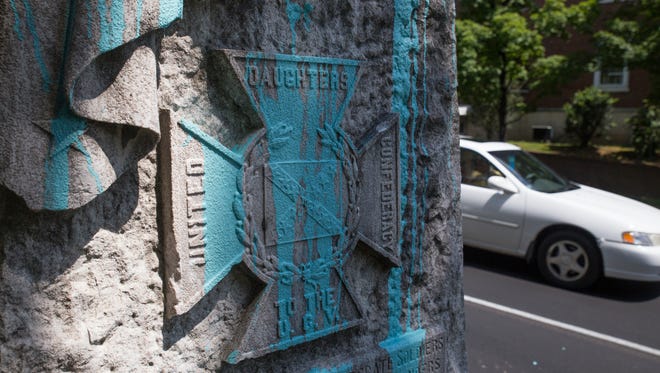Knoxville City Council: Keep Fort Sanders Confederate monument where it is
 Tyler Whetstone
Tyler Whetstone
It may not end up being their call, but several Knoxville City Council members said Thursday they would vote to keep the monument honoring fallen Confederate soldiers in the Fort Sanders neighborhood if it were up to them.
The monument was defaced with green paint Wednesday, a day after petitioners sought to have it taken down. It was originally erected in 1914 by the United Daughters of the Confederacy at the corner of 17th Street and Laurel Avenue.
City officials said they were unaware of the statue, when contacted by USA TODAY NETWORK-Tennessee Wednesday, and said it may be on a public right of way. If it were, according to Knoxville Mayor spokesman Jesse Mayshark, a new state law disallows the city from moving it without a waiver from the State Historical Commission.
After he cut the ribbon for the Cumberland Ave. project completion, Gov. Bill Haslam reiterated comments he's made earlier this week: there's a commission that handles that sort of issue.
“Ultimately whether it’s that bust (Nathan Bedford Forrest) or any monument across the state it has to go through this process which has been prescribed by the legislature,” he said.
Council reaction
Councilmembers Mark Campen and Brenda Palmer said if it were up to them they would vote to keep the monument where it stands. Both said they didn’t think the council would end up voting on it, however.
Campen said removing the monument could start the city down a slippery slope.
“I don’t know that removing this (monument) is the best thing to do. I don’t know all the details of the soldiers’ lives, and I haven’t even read the memorial (yet) … but I think this path we’re going down is a way to cleanse the atrocities of history by removing these monuments, and if that’s the way we’re going, then we have to consider the reality of removing other monuments, accolades, holidays, etc.”

Palmer said the monument is a marker for a historical event and nothing more.
“It identifies what happened there,” Palmer said. “No matter what you think or what you want to think, what happened happened and people were killed there. It identifies what happened in Fort Sanders.”
Councilman Marshall Stair wouldn’t say the monument should stay, but, like Palmer, said the history it marks for the Fort Sanders area is significant.
“I certainly understand the sentiments and arguments for moving (monuments) … but the one in Fort Sanders seems more like a marker than a monument,” he said. “I’d want to think about it, but it does seem different than the Nathan Bedford Forrest bust in the state Capitol."
Councilman Nick Pavlis deferred comment on what should happen to the monument until the city finds out more information. Councilman George Wallace said the city and Knoxville Mayor Madeline Rogero would make the correct decision if it came down to it but he said it was likely a state issue.
Councilmen Nick Della Volpe and Daniel Brown could not be reached for comment. Councilmen Finbarr Saunders and Duane Grieve declined to comment.
Background
For years now, residents in cities across the South have debated what to do with the monuments and statues to Confederate leaders and soldiers. But that debate heightened over the weekend when white supremacists and neo-Nazi groups converged on Charlottesville, Va., to protest the removal of a statue there.
The protests turned deadly when a man drove a car into a crowd of counter-protesters there, killing a 32-year-old woman.
The Fort Sanders monument, which is near a similar monument built in tribute to Union soldiers who died in the famous battle there, is one of few Civil War monuments in the city. Knoxville was a Union stronghold, and even after the war, the city maintained a pro-North sentiment.
Another Confederate monument was built in Bethel Cemetery in the 1890s.